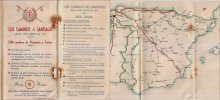Siegfried
Member
- Time of past OR future Camino
- CF 2021 , C -Port 2022, CF 2023
Why not let the Camino self regulate it's occupation level.
If there are too many complaints frequency might go back.
The nice thing of the Camino is that you have no right of assurance of any service.
If you do the camino you do it for yourself, in favour you profit spiritually, religiously.
If some groups book hotels and luggage transport it's fine , it should not bother you sleeping in albergues.
I personally will do a camino this year in East Germany , a quite lonely place, but with albergues on the way
Maybe in 2-3 years I 'll be back on the Frances to regain my findings of life.
If there are too many complaints frequency might go back.
The nice thing of the Camino is that you have no right of assurance of any service.
If you do the camino you do it for yourself, in favour you profit spiritually, religiously.
If some groups book hotels and luggage transport it's fine , it should not bother you sleeping in albergues.
I personally will do a camino this year in East Germany , a quite lonely place, but with albergues on the way
Maybe in 2-3 years I 'll be back on the Frances to regain my findings of life.






































